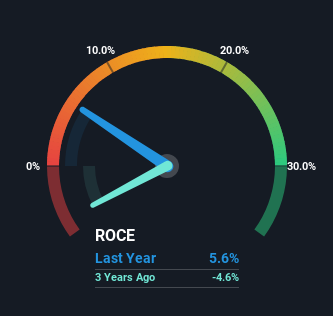- Poland
- /
- Consumer Durables
- /
- WSE:ADX
Adatex (WSE:ADX) Is Looking To Continue Growing Its Returns On Capital
What trends should we look for it we want to identify stocks that can multiply in value over the long term? Firstly, we'd want to identify a growing return on capital employed (ROCE) and then alongside that, an ever-increasing base of capital employed. This shows us that it's a compounding machine, able to continually reinvest its earnings back into the business and generate higher returns. Speaking of which, we noticed some great changes in Adatex's (WSE:ADX) returns on capital, so let's have a look.
What Is Return On Capital Employed (ROCE)?
Just to clarify if you're unsure, ROCE is a metric for evaluating how much pre-tax income (in percentage terms) a company earns on the capital invested in its business. To calculate this metric for Adatex, this is the formula:
Return on Capital Employed = Earnings Before Interest and Tax (EBIT) ÷ (Total Assets - Current Liabilities)
0.056 = zł12m ÷ (zł314m - zł104m) (Based on the trailing twelve months to June 2024).
Thus, Adatex has an ROCE of 5.6%. Ultimately, that's a low return and it under-performs the Consumer Durables industry average of 15%.
View our latest analysis for Adatex

While the past is not representative of the future, it can be helpful to know how a company has performed historically, which is why we have this chart above. If you want to delve into the historical earnings , check out these free graphs detailing revenue and cash flow performance of Adatex.
What Can We Tell From Adatex's ROCE Trend?
We're delighted to see that Adatex is reaping rewards from its investments and is now generating some pre-tax profits. The company was generating losses five years ago, but now it's earning 5.6% which is a sight for sore eyes. Not only that, but the company is utilizing 57,093% more capital than before, but that's to be expected from a company trying to break into profitability. This can tell us that the company has plenty of reinvestment opportunities that are able to generate higher returns.
In another part of our analysis, we noticed that the company's ratio of current liabilities to total assets decreased to 33%, which broadly means the business is relying less on its suppliers or short-term creditors to fund its operations. So shareholders would be pleased that the growth in returns has mostly come from underlying business performance.
In Conclusion...
Overall, Adatex gets a big tick from us thanks in most part to the fact that it is now profitable and is reinvesting in its business. Although the company may be facing some issues elsewhere since the stock has plunged 70% in the last five years. Regardless, we think the underlying fundamentals warrant this stock for further investigation.
If you'd like to know more about Adatex, we've spotted 2 warning signs, and 1 of them is potentially serious.
While Adatex may not currently earn the highest returns, we've compiled a list of companies that currently earn more than 25% return on equity. Check out this free list here.
New: Manage All Your Stock Portfolios in One Place
We've created the ultimate portfolio companion for stock investors, and it's free.
• Connect an unlimited number of Portfolios and see your total in one currency
• Be alerted to new Warning Signs or Risks via email or mobile
• Track the Fair Value of your stocks
Have feedback on this article? Concerned about the content? Get in touch with us directly. Alternatively, email editorial-team (at) simplywallst.com.
This article by Simply Wall St is general in nature. We provide commentary based on historical data and analyst forecasts only using an unbiased methodology and our articles are not intended to be financial advice. It does not constitute a recommendation to buy or sell any stock, and does not take account of your objectives, or your financial situation. We aim to bring you long-term focused analysis driven by fundamental data. Note that our analysis may not factor in the latest price-sensitive company announcements or qualitative material. Simply Wall St has no position in any stocks mentioned.
About WSE:ADX
Adatex
Develops and sells multi-family, service, and commercial buildings in Poland.
Slight risk with mediocre balance sheet.
Market Insights
Community Narratives


Recently Updated Narratives


MINISO's fair value is projected at 26.69 with an anticipated PE ratio shift of 20x


The Quiet Giant That Became AI’s Power Grid


Nova Ljubljanska Banka d.d will expect a 11.2% revenue boost driving future growth
Popular Narratives


The company that turned a verb into a global necessity and basically runs the modern internet, digital ads, smartphones, maps, and AI.


MicroVision will explode future revenue by 380.37% with a vision towards success



